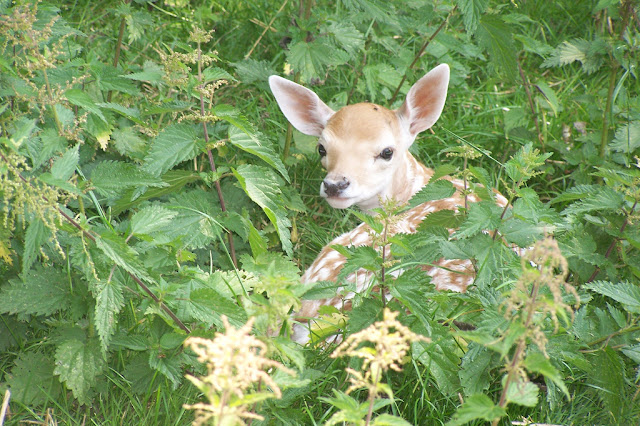Summary: North American stinging nettle gardens give five decades of ornamental barriers in barren, disturbed, high-nutrient and nutrient-deficient soils.
 |
| fawn hiding in stinging nettle (Urtica dioica); Winschoten, Groningen, northeastern Netherlands; Thursday, Feb. 9, 2006, 14:10:50: Jos (ynksjen), CC BY 2.0 Generic, via Wikimedia Commons |
North American stinging nettle gardens accept annual and perennial, native and non-native members of the Urticaceae family whose herbaceous growth acts as a barrier with, and as an ornamental without, stinging nettles.
Plants bear federal, provincial, state or territorial weed designations when their life cycles betray ecosystem well-being and human health, block crop yields and bully species diversity. Fast establishment, high soil tolerances, multiple propagation means and prolific seed production communicate considerations for calling stinging nettles, scientifically named Urtica dioica (burning two houses), weeds. Mexico and the United States do not designate stinging nettles weeds even though provincial legislation in Manitoba and in Quebec describes them as such in Canada.
Stinging nettles enchant and exasperate master gardeners and master naturalists for enduring barren soils, disturbed soils, nutrient deficiencies and nutrient excesses as native North American vegetation.
Oblong, 0.08- to 0.16-inch- (2- to 4-millimeter-) long, 0.04-inch- (1-millimeter-) wide cotyledons, each with distinct midribs, function as embryonic leaves in nettles' shade-loving, sun-intolerant seedling stage.
Stinging nettles, also commonly known as big-sting, California, slender or tall nettles, grow into 19.69- to 118.11-inch- (50- to 300-centimeter-) tall perennials with 50-year life expectancies. They have creeping, elongated, spreading underground stems, called rhizomes, that hustle 8.2-foot (2.5-meter) increases in diameter every year and four-angled stems that harbor irritating, stinging hairs. Dainty pink buds introduce the growing season's fresh shoots on the stems of stinging nettles, described by Swedish botanist Carl Linnaeus (May 23, 1707-Jan. 10, 1778).
The foliar stalks 0.39 to 0.59 inches (10 to 15 millimeters) long in North American stinging nettle gardens join into opposite-positioned arrangements around stinging nettle stems.
The 1.97- to 7.87-inch- (5- to 20-centimeter-) long, 0.79- to 5.12-inch- (2- to 13-centimeter-) wide leaves keep hairy surfaces, heart- to lance-like shapes and toothed margins.
The two 0.19- to 0.48-inch- (5- to 12-millimeter-) long membranous structures, called stipules, at the base of every three- to seven-nerved leaf look brown and papery. Green foliage merges with female-blooming green and male-blooming green-yellow clusters on central, separate, wind-pollinated stalks, with same-sized stalklets, called racemes on branching, pyramid-shaped inflorescences called panicles. Female flowers nestle the ovary-bearing pistil around two 0.06- to 0.07-inch- (1.4- to 1.8-millimeter-) long inner and two 0.03- to 0.05-inch- (0.8- to 1.2-millimeter-) outer sepals.
Male flowers offer four 0.04- to 0.08-inch- (1- to 2-millimeter-) long sepals and four stamens in May to September blooms in North American stinging nettle gardens.
The flowering stage of blooms less than 0.08 inches (2 millimeters) across paves the way for the fruiting of achenes within the inner female-flowering papery sepals.
The shedding of dry, one-seeded achenes quickens seed germination to within five to 10 days of dispersal and viability in soil for the ensuing 10 years. Narrow wings reach around each dull orange to pale brown, oval, 0.04- to 0.06-inch- (1- to 1.5-millimeter-) long, 0.03- to 0.04-inch- (0.7- to 1-millimeter-) wide seed. Stinging nettles each scatter as many as 20,000 seeds even when the related native pellitory and wood nettle and non-native dog or small nettle share space.
Dog nettle and pellitory without, and stinging and wood nettles with, stinging hairs temper North American stinging nettle gardens with 50 years of natural ornamental barriers.
 |
| stinging nettle (Urtica dioica); Isenberg, Hattingen, northwestern Germany: Simplicius, CC BY SA 3.0 Unported, via Wikimedia Commons |
Acknowledgment
My special thanks to talented artists and photographers/concerned organizations who make their fine images available on the internet.
Image credits:
Image credits:
fawn hiding in stinging nettle (Urtica dioica); Winschoten, Groningen, northeastern Netherlands; Thursday, Feb. 9, 2006, 14:10:50: Jos (ynksjen), CC BY 2.0 Generic, via Wikimedia Commons @ https://commons.wikimedia.org/wiki/File:Fawn_in_Winschoten_(ynskjen).jpg;
Jos (ynskjen), CC BY 2.0 Generic, via Flickr @ https://www.flickr.com/photos/20299709@N00/178434302/
Jos (ynskjen), CC BY 2.0 Generic, via Flickr @ https://www.flickr.com/photos/20299709@N00/178434302/
stinging nettle (Urtica dioica); Isenberg, Hattingen, northwestern Germany: Simplicius, CC BY SA 3.0 Unported, via Wikimedia Commons @ https://commons.wikimedia.org/wiki/File:Brennnessel.jpg
For further information:
For further information:
Dickinson, Richard; and Royer, France. 2014. Weeds of North America. Chicago IL; London, England: The University of Chicago Press.
Linnaeus, Carl. 1753. "4. Urtica dioica." Species Plantarum, vol. II: 984. Holmiae [Stockholm, Sweden]: Laurentii Salvi [Laurentius Salvius].
Available via Biodiversity Heritage Library @ http://biodiversitylibrary.org/page/359005
Available via Biodiversity Heritage Library @ http://biodiversitylibrary.org/page/359005
"Urtica dioica L." Tropicos® > Name Search.
Available @ http://www.tropicos.org/Name/33400020
Available @ http://www.tropicos.org/Name/33400020
Weakley, Alan S.; Ludwig, J. Christopher; and Townsend, John F. 2012. Flora of Virginia. Edited by Bland Crowder. Fort Worth TX: BRIT Press, Botanical Research Institute of Texas.
No comments:
Post a Comment
Note: Only a member of this blog may post a comment.